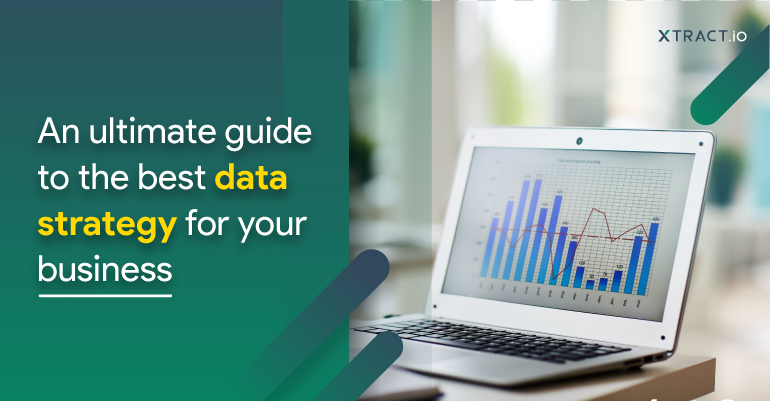In today’s world, data plays a huge role in the success of businesses. It’s like having a crystal ball that gives you insights into what your audience wants, what they like, and how they behave. According to Statista, the amount of data businesses consume daily has increased from 64.2 zettabytes in 2020 to 120 zettabytes in 2023. With so much data available, it is important to have the plan to ensure that the right data is being collected and used in the most effective way possible. Hence, a well-crafted data strategy is essential for any business looking to thrive in the modern marketplace.
What is a data strategy?
As a business owner, you understand the importance of making informed decisions. The right data strategy can help you do just that. A data strategy is a plan for gathering, storing, and analyzing data. For example, if a business is collecting data on customer behavior but has no plan on how to use it, it may be collecting data for no reason. A well-thought-out strategy allows businesses to turn data into insights that drive growth and success. In short, a data strategy is a roadmap for an organization’s journey to turn data into actionable information.
How to choose the right data strategy for your business?
Choosing a data strategy for your business can be a complex process, but here are some steps that can guide you:
- Define your business goals and objectives: Start by understanding what your organization wants to achieve and what data will help you reach those goals.
- Assess your current data landscape: Understand your data, where it is stored, and how it is used. This will give you a baseline to build upon.
- Identify key data stakeholders: Identify the key individuals within the organization who your data strategy will impact. This includes IT, business units, and key decision-makers.
- Evaluate technology and infrastructure: Determine the technology and infrastructure you need to support your data strategy. This includes data storage, processing, and analysis tools.
- Define data governance and management policies: Establish clear policies for data governance and management, including data privacy, security, and retention.
- Continuously review and refine: Regularly review your data strategy and make changes as necessary. Stay flexible and agile, and be prepared to make adjustments as your business and data needs evolve.
By following these steps, you can ensure that your data strategy is aligned with your business goals and supports your organization’s growth and success.
What are the 2 types of data strategies?
Organizations use two types of data strategies to make informed decisions. They are descriptive and predictive data strategies. The descriptive strategy focuses on understanding and summarizing data, while the prescriptive strategy involves using data to make decisions and predictions. Get ready to learn more about these strategies that drive the data world!
What is a descriptive strategy?
A descriptive data strategy involves summarizing and understanding the features of a data set. This approach provides a snapshot of the data without making inferences or predictions about the underlying trends and patterns. But rather, it provides a comprehensive summary of the data as it is. It provides clear and concise insights into the data, making it easier to understand and interpret.
This data strategy is often used in a study’s initial stages to understand the data better and identify potential anomalies or outliers. The goal is to provide an accurate and detailed description of the datasets collected. This information can guide further analysis and decision-making in various industries, including retail, hospitality, e-commerce, and finance.
For example, an online marketplace can use a descriptive data strategy to understand customer information. They can track and collect data on the most frequently searched products, the average time spent on the site, and the traffic sources. This information can help the marketplace optimize its website, improve search functionality, and effectively target advertising.
What is a predictive strategy?
A predictive data strategy is a process of using data and statistical models to forecast future outcomes. It involves analyzing historical data to identify patterns and trends, which can then be used to predict future events. Predictive data strategies can be applied in various fields, including marketing, finance, and healthcare, to support decision-making and inform future planning.
To implement a predictive data strategy, businesses must first collect and clean relevant data, select an appropriate method, and validate the results. A predictive data strategy aims to generate accurate predictions and insights that can drive better business outcomes, such as improved customer experiences, optimized operations, and reduced risks.
One perfect example is Netflix using predictive analytics to suggest shows to its viewers based on their watch history and ratings. The platform’s algorithms continuously gather data on user behavior and make personalized recommendations accordingly. If you’ve been binge-watching romantic comedies, you might see suggestions for similar content. This helps increase customer engagement and keeps them on the platform for longer periods of time. This ultimately drives profits for Netflix.
Summary
Both strategies play an important role in data-driven decision-making, and a combination of both can lead to better outcomes. When choosing a data strategy, it’s important to align it with your business goals, assess your current data landscape, and continuously refine and adjust it as your business and data needs evolve. Doing so can ensure that your data strategy supports your organization’s growth and success.
Xtract.io offers a user-friendly data management platform streamlines the extraction and analysis process. Our simple features make it easy for organizations to turn data into actionable insights, drive better decision-making, and achieve their goals. If you are looking for a more robust solution, Xtract.io is worth considering. Request a free demo!







